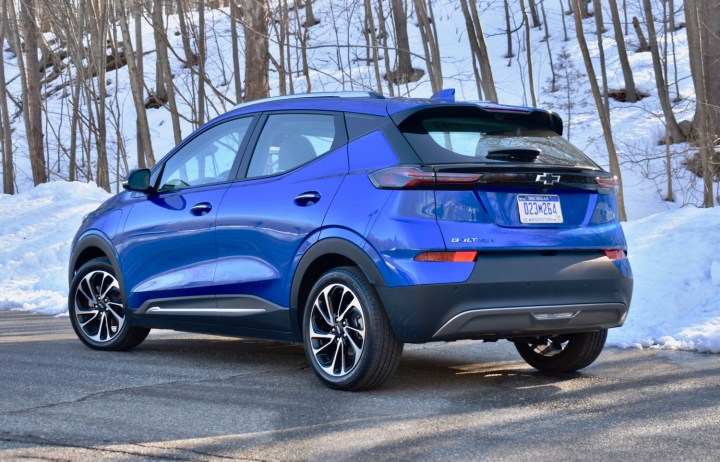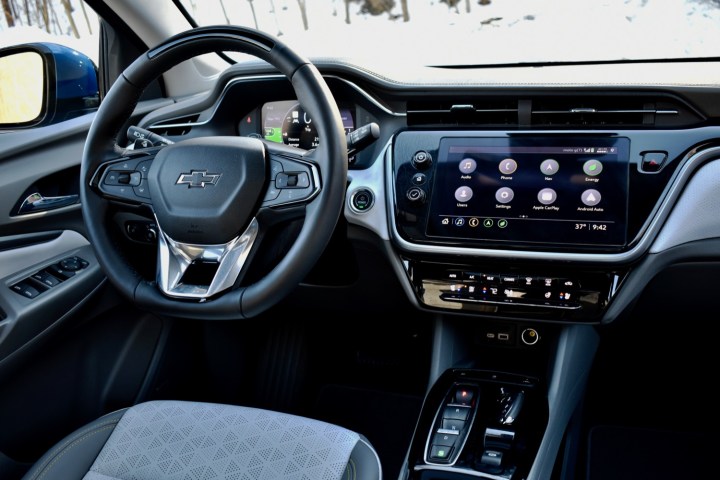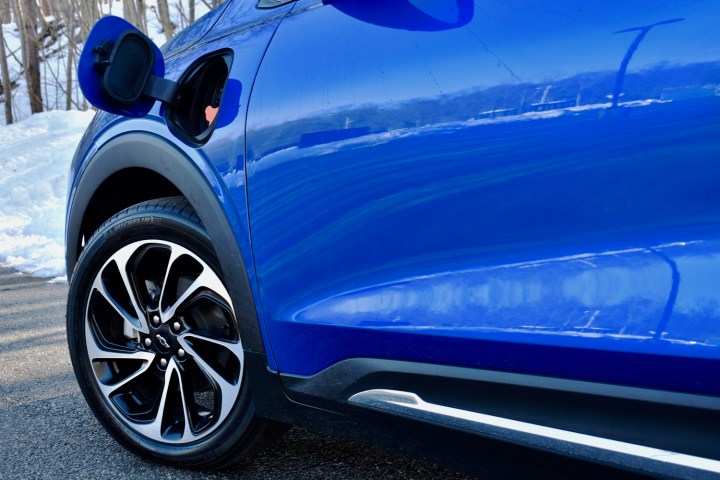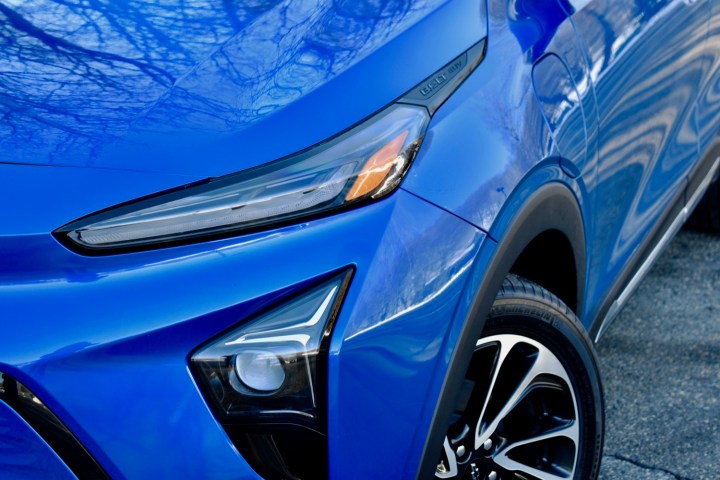With a range of more than 200 miles, and a base price under $40,000, the first-generation Chevrolet Bolt EV was an electric-car game-changer, but where does Chevy go from there?
For the Bolt EV’s first major update, Chevy redesigned the exterior and interior, and added a second model to the lineup. The 2022 Chevrolet Bolt EUV was meant to be a more SUV-like alternative to the standard Bolt EV, with a more upright profile and more rear-seat space. The EUV is also the first non-Cadillac model to get General Motors’ Super Cruise driver-assist system.
While the original Bolt EV was well ahead of the competition at its 2017-model-year launch, the two 2022 Bolt models face off against the Hyundai Kona Electric, Kia Niro EV, Nissan Leaf, and the newly-minted Volkswagen ID.4 for a share of what remains a very small EV market.
Chevy has launched the Bolt EUV in LT, Premier, and Launch Edition trim levels. Pricing starts at $33,995 for the LT base model but can go as high as $43,495 for a fully-loaded Launch Edition model. The base price is $2,000 more than a 2022 Bolt EV, but still $3,500 less than a 2021 Bolt EV. The lower prices help account for the fact that GM vehicles are no longer eligible for the federal EV tax credit.
Design and interior
Both the 2022 Bolt EUV and 2022 Bolt EV get similar exterior styling, with a more aggressive look than the previous Bolt EV. Chevy says no exterior panels are shared between the EV and EUV, but the broad strokes are the same. Both models have the same “face,” with multi-element lighting (the thin elements at the top that look like headlights are actually the daytime running lights and turn signals), a phantom grille, and a beak-like shape.
The Bolt EUV is 0.2 inches taller and wider than the Bolt EV, and about 6.0 inches longer. That allows for a 2.9-inch longer wheelbase, which in turn gives the EUV 3.1 inches of additional rear legroom over the Bolt EV. That’s the only area where the EUV has an advantage on passenger space, though. The two versions have identical front legroom, and the Bolt EV actually has more headroom in both rows. The EUV isn’t an SUV version of the Bolt EV, but it will make rear-seat passengers happier. It’s a Bolt EV for Uber drivers.
The EUV will make rear-seat passengers happier. It’s a Bolt EV for Uber drivers.
This ride-share-ready Chevy also has more legroom in both rows than its rivals, but the Volkswagen ID.4 has more front and rear headroom. At 16.3 cubic feet with the rear seats in place, and 56.9 cubic feet with the rear seats folded, the Bolt EUV actually has slightly less cargo space than the Bolt EV. That 16.3-cubic-foot figure is also the worst among the Bolt EUV’s competitive set, but most other mainstream EVs don’t offer as much cargo space with the back seats folded. The exception, again, is the Volkswagen ID.4, which offers nearly twice the amount of cargo space as the Bolt EUV with the rear seats in place.
The interior seems like a mix of features thrown together without a coherent design. It lacks the futuristic look of the VW ID.4 cabin but also isn’t as plain as the Nissan Leaf’s interior. The standout features are a flat-bottom steering wheel and a set of toggles in place of a conventional shifter. The Bolt EUV also gets the same redesigned seats as the Bolt EV, replacing lightweight versions that many owners disliked, with cloth upholstery on LT models and leather on Premier models.
Tech, infotainment, and driver assist
The standard infotainment system includes a 10.2-inch touchscreen and 8.0-inch digital instrument cluster, with wireless Apple CarPlay and Android Auto, as well as wireless phone charging. Amazon Alexa connectivity and a 4G LTE Wi-Fi hotspot are also available.
The main touchscreen sported well-designed menus and graphics, including a detailed energy-flow animation that lets you keep track of what the powertrain is doing. The instrument cluster looked a bit cluttered, with too many small icons and readouts.
The Bolt EUV is the first vehicle outside the Cadillac luxury brand to get GM’s Super Cruise system. Not available on the Bolt EV, Super Cruise allows for automated acceleration, braking, and lane centering on designated stretches of pre-mapped highways (GM says it’s mapped more than 200,000 miles in the United States and Canada to date). It’s marketed by GM as a hands-free system, but the driver still has to pay attention and be ready to take over at any moment. The system also uses driver monitoring to guard against misuse.
Super Cruise is the real deal. Our experience checked the most important boxes.
Super Cruise is the real deal. While we didn’t get to take the Bolt EUV on a long road trip, our brief experience on typically-chaotic New Jersey highways checked the most important boxes.
First, Super Cruise kept the car dead center — even on the gentle curves you’ll inevitably encounter on most highways. It also steered smoothly, not letting the car ping-pong back and forth between lanes. Second, acceleration and deceleration were prompt. Super Cruise responded quickly when dialing up the set speed, and when other cars cut in front. Finally, it’s easy to use. Just wait for the dashboard icon to illuminate, press a button, and you’re good to go. The system also gave plenty of warning when we were about to exit a Super Cruise-approved zone, and needed to take back control.
Super Cruise is an optional extra on the Premier and Launch Edition trim levels, but the Bolt EUV does come standard with automatic emergency braking, forward-collision warning, lane-keep assist, lane-departure warning, a forward-distance indicator, and front pedestrian braking. Rear cross-traffic alert, a surround-view camera system, rearview camera mirror, and adaptive cruise control are also available, but not standard.
Driving experience
The Bolt EUV powertrain carries over from the previous-generation Bolt EV. That means you get a single electric motor producing 200 horsepower and 266 pound-feet of torque, powered by a 65-kilowatt-hour battery pack, with front-wheel drive.
Chevy estimates zero to 60 mph in about 7.0 seconds, similar to what Volkswagen previously told us an ID.4 can do. Like all electric cars, instantaneous torque gets you off the line in a hurry, but that was the only dramatic thing about the Bolt EUV. We loved the previous-generation Bolt EV’s agility, but some of that seems to have been dialed out by the EUV’s longer wheelbase, as well as steering that was a tad on the heavy side.
The Bolt EUV has the makings of a good daily driver, including a comfortable ride.
The Bolt EUV wasn’t designed to be a performance car, though. It’s got the makings of a good daily driver, including a comfortable ride (it dealt with potholes better than some actual SUVs) and (thanks to that electric powertrain) a quiet cabin. Like many of today’s gasoline cars, the driving experience just wasn’t that remarkable.
The Bolt EUV uses regenerative braking, allowing it to recover energy while decelerating that would normally be lost as heat. Chevy offers more options for controlling the level of regeneration than competitors, though. You get a steering-wheel paddle, as well as a button for so-called “one-pedal driving.” Pressing the button summoned enough regen to handle most braking, while pulling the paddle added a bit more, for an effect similar to engine braking in a gasoline car. It seems like something EV fans will appreciate, but average drivers also don’t have to bother with it.
Range, charging, and safety
Chevy estimates 250 miles of range for the Bolt EUV. That’s nine miles less than the Bolt EV, and eight miles less than the Hyundai Kona Electric, but still more than the Nissan Leaf Plus or Kia Niro EV. Efficiency ratings haven’t been published.
The standard 11-kilowatt onboard charger allows for a full recharge in seven hours from a 240-volt Level 2 AC charging station. The Bolt EUV also comes standard with Chevy’s Dual Level Charge Cord, which allows the car to plug directly into 120-volt or 240-volt outlets, albeit with a lower power level of 7.2 kW. Chevy will cover installation costs for a 240-volt outlet—but only through June 2021.
The Bolt EUV also gets standard DC fast-charging capability, which can recover up to 95 miles of range in 30 minutes, according to Chevy. All GM vehicles use the Combined Charging Standard (CCS) for DC fast charging, which is now second only to Tesla’s Supercharger standard in number of stations.
Crash-test ratings from the National Highway Traffic Safety Administration (NHTSA) and Insurance Institute for Highway Safety (IIHS) haven’t been published yet. That is typical for new models.
Chevy offers a three-year, 36,000-mile, bumper-to-bumper warranty, a five-year, 60,000-mile, powertrain warranty, and an eight-year, 100,000-mile, battery warranty. Those are pretty standard terms for an EV in the current market.
How DT would configure this car
If you want tech, the only option is to upgrade from the base Bolt EUV LT trim level to the Premier, as it’s available with Super Cruise and the rearview camera mirror. Super Cruise is also included on the Bolt EUV Launch Edition, but that’s a limited-edition model that won’t be part of the regular lineup.
However, Chevy has created a bit of a conundrum. The standard Bolt EV is less expensive than the Bolt EUV, with similar interior dimensions, more cargo space, and (slightly) more range. Yet the Bolt EV doesn’t get Super Cruise. The Bolt EUV also gets some features — including wireless phone charging and the Dual Level Charge Cord — that are extra-cost options on the Bolt EV as standard equipment.
While we didn’t get to drive it, the Bolt EV seems like the more sensible choice in terms of cost and functionality, but the Bolt EUV is the better choice for tech. It’s too bad Chevy forces buyers to choose, rather than offering one model that covers all the bases.
Our take
The Bolt EV was ahead of the competition when it launched for the 2017 model year, so Chevy didn’t have to work too hard to keep the 2022 model competitive. The Bolt EUV adds important upgrades, including Super Cruise, a redesigned interior, and more rear-seat space.
Was that enough, though? The EUV really beats the Bolt EV only on rear legroom, but its lack of headroom won’t fool anyone into thinking it’s an SUV. You also have to fold down the rear seats to get a decent amount of cargo space, which defeats the purpose of this stretched version of the Bolt.
The 250-mile range is still impressive, and so is the Bolt EUV’s $33,995 base price, which undercuts most rivals. Start adding features like Super Cruise though, and the price gap between a Bolt EUV and a Nissan Leaf or Volkswagen ID.4 starts to shrink. Nissan and VW have driver-assist systems of their own, but they can’t match the capabilities of Super Cruise. However, the ID.4 will soon be available with all-wheel drive, and Nissan is launching its Ariya electric SUV. Those seem like better alternatives who want a true utility vehicle, rather than just an electric car.
While the original Bolt EV will be remembered as a milestone in the democratization of the electric car, history will likely remember the Bolt EUV for bringing the previously Cadillac-exclusive Super Cruise to a humble Chevy. That’s all right. Chevy already reinvented the wheel once. Now it needs to let it roll.
Should you get one?
Yes. It may not be a game-changer like the original Bolt EV, but the Bolt EUV is still a good electric car.







